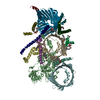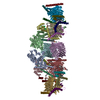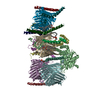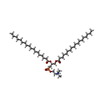+ Open data
Open data
- Basic information
Basic information
| Entry |  | |||||||||
|---|---|---|---|---|---|---|---|---|---|---|
| Title | Import stalled PINK1 TOM complex, symmetry expanded | |||||||||
 Map data Map data | Main map | |||||||||
 Sample Sample |
| |||||||||
 Keywords Keywords | PINK1 / TOM complex / VDAC / TRANSLOCASE | |||||||||
| Function / homology |  Function and homology information Function and homology informationpositive regulation of synaptic transmission, dopaminergic / positive regulation of free ubiquitin chain polymerization / tRNA import into mitochondrion / TOM complex / positive regulation of cristae formation / voltage-gated monoatomic anion channel activity / mitochondrial transmembrane transport / mitochondrial outer membrane permeabilization / regulation of protein targeting to mitochondrion / Mitochondrial calcium ion transport ...positive regulation of synaptic transmission, dopaminergic / positive regulation of free ubiquitin chain polymerization / tRNA import into mitochondrion / TOM complex / positive regulation of cristae formation / voltage-gated monoatomic anion channel activity / mitochondrial transmembrane transport / mitochondrial outer membrane permeabilization / regulation of protein targeting to mitochondrion / Mitochondrial calcium ion transport / mitochondrion to lysosome vesicle-mediated transport / maintenance of protein location in mitochondrion / mitochondrion targeting sequence binding / establishment of protein localization to mitochondrion / protein kinase B binding / mitochondrial outer membrane translocase complex / cellular response to hydrogen sulfide / Lewy body / phospholipid scramblase activity / regulation of autophagy of mitochondrion / protein insertion into mitochondrial outer membrane / ceramide binding / regulation of synaptic vesicle transport / TORC2 signaling / negative regulation of hypoxia-induced intrinsic apoptotic signaling pathway / mitochondria-associated endoplasmic reticulum membrane contact site / positive regulation of mitochondrial electron transport, NADH to ubiquinone / regulation of hydrogen peroxide metabolic process / regulation of oxidative phosphorylation / migrasome / negative regulation of hydrogen peroxide-induced neuron intrinsic apoptotic signaling pathway / C3HC4-type RING finger domain binding / regulation of cellular response to oxidative stress / protein-transporting ATPase activity / dopamine secretion / voltage-gated monoatomic ion channel activity / negative regulation of autophagosome assembly / positive regulation of dopamine secretion / binding of sperm to zona pellucida / autophagy of mitochondrion / phosphatidylcholine binding / oxysterol binding / positive regulation of type 2 mitophagy / Mitochondrial protein import / cellular response to toxic substance / negative regulation of oxidative stress-induced neuron intrinsic apoptotic signaling pathway / regulation of mitochondrion organization / monoatomic anion transport / negative regulation of JNK cascade / positive regulation of ubiquitin-protein transferase activity / positive regulation of protein targeting to mitochondrion / negative regulation of intrinsic apoptotic signaling pathway in response to hydrogen peroxide / regulation of reactive oxygen species metabolic process / peptidase activator activity / phospholipid translocation / protein targeting to mitochondrion / cholesterol binding / astrocyte projection / positive regulation of mitochondrial fission / negative regulation of macroautophagy / porin activity / negative regulation of mitophagy / pore complex / FOXO-mediated transcription of cell death genes / negative regulation of intrinsic apoptotic signaling pathway / protein import into mitochondrial matrix / positive regulation of release of cytochrome c from mitochondria / positive regulation of ATP biosynthetic process / hemopoiesis / negative regulation of reactive oxygen species metabolic process / mitochondrial nucleoid / positive regulation of macroautophagy / protein transmembrane transporter activity / regulation of protein ubiquitination / regulation of protein-containing complex assembly / negative regulation of mitochondrial fission / mitophagy / regulation of proteasomal protein catabolic process / monoatomic ion transport / sperm midpiece / acrosomal vesicle / positive regulation of translation / response to ischemia / positive regulation of protein ubiquitination / PINK1-PRKN Mediated Mitophagy / cell periphery / regulation of mitochondrial membrane potential / respiratory electron transport chain / mitochondrion organization / macroautophagy / mitochondrial membrane / regulation of protein stability / mitochondrial intermembrane space / kinase binding / kinase activity / unfolded protein binding / cell body / growth cone / response to oxidative stress / cellular response to oxidative stress Similarity search - Function | |||||||||
| Biological species |  Homo sapiens (human) Homo sapiens (human) | |||||||||
| Method | single particle reconstruction / cryo EM / Resolution: 2.75 Å | |||||||||
 Authors Authors | Kirk NS / Glukhova A / Callegari S / Komander D | |||||||||
| Funding support |  Australia, 2 items Australia, 2 items
| |||||||||
 Citation Citation |  Journal: Science / Year: 2025 Journal: Science / Year: 2025Title: Structure of human PINK1 at a mitochondrial TOM-VDAC array. Authors: Sylvie Callegari / Nicholas S Kirk / Zhong Yan Gan / Toby Dite / Simon A Cobbold / Andrew Leis / Laura F Dagley / Alisa Glukhova / David Komander /  Abstract: Mutations in the ubiquitin kinase PINK1 cause early-onset Parkinson's disease, but how PINK1 is stabilized at depolarized mitochondrial translocase complexes has remained poorly understood. We ...Mutations in the ubiquitin kinase PINK1 cause early-onset Parkinson's disease, but how PINK1 is stabilized at depolarized mitochondrial translocase complexes has remained poorly understood. We determined a 3.1-angstrom resolution cryo-electron microscopy structure of dimeric human PINK1 stabilized at an endogenous array of mitochondrial translocase of the outer membrane (TOM) and voltage-dependent anion channel (VDAC) complexes. Symmetric arrangement of two TOM core complexes around a central VDAC2 dimer is facilitated by TOM5 and TOM20, both of which also bind PINK1 kinase C-lobes. PINK1 enters mitochondria through the proximal TOM40 barrel of the TOM core complex, guided by TOM7 and TOM22. Our structure explains how human PINK1 is stabilized at the TOM complex and regulated by oxidation, uncovers a previously unknown TOM-VDAC assembly, and reveals how a physiological substrate traverses TOM40 during translocation. | |||||||||
| History |
|
- Structure visualization
Structure visualization
| Supplemental images |
|---|
- Downloads & links
Downloads & links
-EMDB archive
| Map data |  emd_48084.map.gz emd_48084.map.gz | 5.7 MB |  EMDB map data format EMDB map data format | |
|---|---|---|---|---|
| Header (meta data) |  emd-48084-v30.xml emd-48084-v30.xml emd-48084.xml emd-48084.xml | 28.8 KB 28.8 KB | Display Display |  EMDB header EMDB header |
| FSC (resolution estimation) |  emd_48084_fsc.xml emd_48084_fsc.xml | 22.2 KB | Display |  FSC data file FSC data file |
| Images |  emd_48084.png emd_48084.png | 69 KB | ||
| Filedesc metadata |  emd-48084.cif.gz emd-48084.cif.gz | 8.3 KB | ||
| Others |  emd_48084_half_map_1.map.gz emd_48084_half_map_1.map.gz emd_48084_half_map_2.map.gz emd_48084_half_map_2.map.gz | 1 GB 1 GB | ||
| Archive directory |  http://ftp.pdbj.org/pub/emdb/structures/EMD-48084 http://ftp.pdbj.org/pub/emdb/structures/EMD-48084 ftp://ftp.pdbj.org/pub/emdb/structures/EMD-48084 ftp://ftp.pdbj.org/pub/emdb/structures/EMD-48084 | HTTPS FTP |
-Validation report
| Summary document |  emd_48084_validation.pdf.gz emd_48084_validation.pdf.gz | 908.9 KB | Display |  EMDB validaton report EMDB validaton report |
|---|---|---|---|---|
| Full document |  emd_48084_full_validation.pdf.gz emd_48084_full_validation.pdf.gz | 908.5 KB | Display | |
| Data in XML |  emd_48084_validation.xml.gz emd_48084_validation.xml.gz | 30.8 KB | Display | |
| Data in CIF |  emd_48084_validation.cif.gz emd_48084_validation.cif.gz | 40 KB | Display | |
| Arichive directory |  https://ftp.pdbj.org/pub/emdb/validation_reports/EMD-48084 https://ftp.pdbj.org/pub/emdb/validation_reports/EMD-48084 ftp://ftp.pdbj.org/pub/emdb/validation_reports/EMD-48084 ftp://ftp.pdbj.org/pub/emdb/validation_reports/EMD-48084 | HTTPS FTP |
-Related structure data
| Related structure data |  9eiiMC  9eihC  9eijC M: atomic model generated by this map C: citing same article ( |
|---|---|
| Similar structure data | Similarity search - Function & homology  F&H Search F&H Search |
- Links
Links
| EMDB pages |  EMDB (EBI/PDBe) / EMDB (EBI/PDBe) /  EMDataResource EMDataResource |
|---|---|
| Related items in Molecule of the Month |
- Map
Map
| File |  Download / File: emd_48084.map.gz / Format: CCP4 / Size: 216 MB / Type: IMAGE STORED AS FLOATING POINT NUMBER (4 BYTES) Download / File: emd_48084.map.gz / Format: CCP4 / Size: 216 MB / Type: IMAGE STORED AS FLOATING POINT NUMBER (4 BYTES) | ||||||||||||||||||||||||||||||||||||
|---|---|---|---|---|---|---|---|---|---|---|---|---|---|---|---|---|---|---|---|---|---|---|---|---|---|---|---|---|---|---|---|---|---|---|---|---|---|
| Annotation | Main map | ||||||||||||||||||||||||||||||||||||
| Projections & slices | Image control
Images are generated by Spider. | ||||||||||||||||||||||||||||||||||||
| Voxel size | X=Y=Z: 0.833 Å | ||||||||||||||||||||||||||||||||||||
| Density |
| ||||||||||||||||||||||||||||||||||||
| Symmetry | Space group: 1 | ||||||||||||||||||||||||||||||||||||
| Details | EMDB XML:
|
-Supplemental data
-Half map: Half map B
| File | emd_48084_half_map_1.map | ||||||||||||
|---|---|---|---|---|---|---|---|---|---|---|---|---|---|
| Annotation | Half map B | ||||||||||||
| Projections & Slices |
| ||||||||||||
| Density Histograms |
-Half map: Half map A
| File | emd_48084_half_map_2.map | ||||||||||||
|---|---|---|---|---|---|---|---|---|---|---|---|---|---|
| Annotation | Half map A | ||||||||||||
| Projections & Slices |
| ||||||||||||
| Density Histograms |
- Sample components
Sample components
+Entire : Complex of VDAC, TOM core and PINK1
+Supramolecule #1: Complex of VDAC, TOM core and PINK1
+Macromolecule #1: Serine/threonine-protein kinase PINK1, mitochondrial
+Macromolecule #2: Mitochondrial import receptor subunit TOM20 homolog
+Macromolecule #3: Voltage-dependent anion-selective channel protein 2
+Macromolecule #4: Mitochondrial import receptor subunit TOM40 homolog
+Macromolecule #5: Mitochondrial import receptor subunit TOM5 homolog
+Macromolecule #6: Mitochondrial import receptor subunit TOM7 homolog
+Macromolecule #7: Mitochondrial import receptor subunit TOM6 homolog
+Macromolecule #8: Mitochondrial import receptor subunit TOM22 homolog
+Macromolecule #9: 1,2-DIACYL-SN-GLYCERO-3-PHOSPHOCHOLINE
-Experimental details
-Structure determination
| Method | cryo EM |
|---|---|
 Processing Processing | single particle reconstruction |
| Aggregation state | particle |
- Sample preparation
Sample preparation
| Concentration | 4.3 mg/mL |
|---|---|
| Buffer | pH: 7.4 |
| Vitrification | Cryogen name: ETHANE / Chamber humidity: 90 % / Chamber temperature: 277 K / Instrument: FEI VITROBOT MARK IV / Details: Blot force 10 for 2 s.. |
- Electron microscopy
Electron microscopy
| Microscope | TFS KRIOS |
|---|---|
| Image recording | Film or detector model: GATAN K3 BIOQUANTUM (6k x 4k) / Number grids imaged: 2 / Number real images: 16992 / Average exposure time: 3.34 sec. / Average electron dose: 52.4 e/Å2 |
| Electron beam | Acceleration voltage: 300 kV / Electron source:  FIELD EMISSION GUN FIELD EMISSION GUN |
| Electron optics | C2 aperture diameter: 50.0 µm / Illumination mode: FLOOD BEAM / Imaging mode: BRIGHT FIELD / Cs: 2.7 mm / Nominal defocus max: 2.0 µm / Nominal defocus min: 0.5 µm / Nominal magnification: 105000 |
| Sample stage | Specimen holder model: FEI TITAN KRIOS AUTOGRID HOLDER / Cooling holder cryogen: NITROGEN |
| Experimental equipment |  Model: Titan Krios / Image courtesy: FEI Company |
+ Image processing
Image processing
-Atomic model buiding 1
| Initial model | PDB ID: Chain - Source name: PDB / Chain - Initial model type: experimental model |
|---|---|
| Refinement | Space: REAL / Protocol: FLEXIBLE FIT |
| Output model |  PDB-9eii: |
-Atomic model buiding 2
| Initial model | Chain - Source name: AlphaFold / Chain - Initial model type: in silico model |
|---|---|
| Refinement | Space: REAL / Protocol: FLEXIBLE FIT |
| Output model |  PDB-9eii: |
 Movie
Movie Controller
Controller









 Z (Sec.)
Z (Sec.) Y (Row.)
Y (Row.) X (Col.)
X (Col.)







































